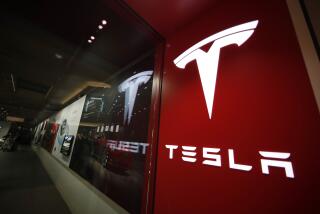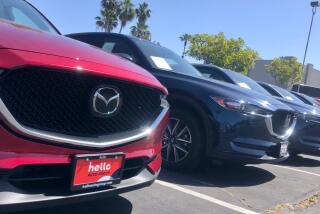Toyota’s Profit Down 1.5% in Second Quarter
- Share via
Toyota Motor Corp. said Monday that its fiscal second-quarter profit dropped 1.5%, and the company echoed rival Japanese automakers in blaming the decline on unfavorable currency rates and soaring raw-materials costs.
Toyota reported a quarterly profit of 297.4 billion yen ($2.8 billion), down from 302 trillion yen a year earlier, although the profit slowdown was less severe than those reported last week by its chief Japanese rivals.
By contrast, Nissan Motor Co.’s second-quarter profit fell 7.5% and Honda Motor Co.’s was off 3.5%
Toyota’s sales for the quarter ended Sept. 30 rose 9% to 4.5 trillion yen ($42.5 billion) from 4.1 trillion yen a year earlier.
Toyota is Japan’s largest automaker and the second-largest in the world, behind General Motors Corp.
Toyota’s strong presence in the U.S. market accounts for about a third of its global sales and helped keep the company’s quarterly performance from declining further. In the U.S., Toyota’s sales are up 9.4% for the first nine months of the year, to 1.5 million cars and trucks, and its market share is a record 12.1%.
This year’s sales increase is occurring against a backdrop of frantic incentive spending by the domestic car companies.
“But we’ve been able to avoid those high marketing and incentive costs,” said Jim Press, executive vice president of Torrance-based Toyota Motor Sales USA. The company’s incentive spending in the U.S. averaged $845 a vehicle at the end of September, according to Autodata, compared with $4,340 for General Motors and $2,137 for Nissan.
Toyota has been able to hold the line because of its reputation for reliable vehicles that offer good value. Models of the just-introduced 2005 Tacoma pickup truck, for instance, are priced about $1,000 less than comparably equipped 2004 models.
Press said Toyota expected “continued good growth” in the U.S., spurred by a host of new products over the next year. They include the Lexus 400h and Toyota Highlander gasoline-and-electric-powered hybrid SUVs and the redesigned Toyota Avalon and Lexus GS sedans. Toyota also has increased production of the popular Prius hybrid sedan and expects U.S. sales of the vehicle to hit 100,000 units next year.
The rosy outlook is tempered, though, by concerns about rising costs and a continued weak dollar. “We will have to fight hard to maintain last year’s profit level” even with rising sales, Press said.
The company avoids some of the pain of the rising yen because it makes about two-thirds of the cars and trucks it sells in North America at four assembly plants in the U.S. and Canada. A fifth plant, in Tijuana, is expected to begin producing Tacoma pickup trucks by the end of the year.
Toyota Chairman Hiroshi Okuda said Monday that the company planned to add another production plant in North America in the next few years.
The North American plants are valuable because they cut shipping costs and use local parts for about 75% of their content, reducing Toyota’s exposure to currency fluctuations.
The rising yen has lowered the value of U.S. earnings for all Japanese carmakers by about 7%. The exchange rate cut 120 billion yen from Toyota’s net earnings for its fiscal first half. But a global cost-cutting drive added 330 billion yen to its income in the April-to-September period.
Toyota’s U.S. shares fell 64 cents Monday to $76.95 on the New York Stock Exchange.
Times wire services were used in compiling this report.
More to Read
Inside the business of entertainment
The Wide Shot brings you news, analysis and insights on everything from streaming wars to production — and what it all means for the future.
You may occasionally receive promotional content from the Los Angeles Times.










